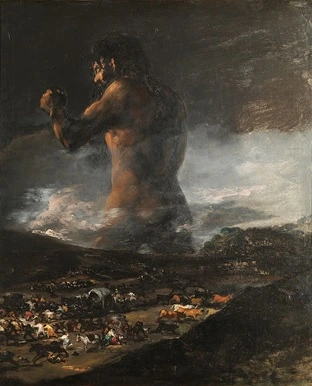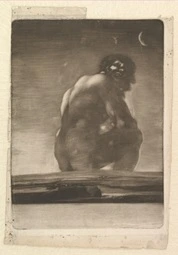THE COLOSSUS
In 1913, The Colossus was given to the Museo del Prado. It was thought to be an authentic Goya. Recently, its authenticity has been questioned. The painting, also known as The Giant – or in Spanish as El Coloso, El Gigante, El Pánico, or La Tormenta – has been considered one of Goya's masterpieces. The composition is based on Goya's print entitled Seated Giant. Javier Goya, Goya's son, inherited the painting in 1812.

The Colossus (El Coloso) (1808–1812), Museo Del Prado, Madrid, Spain

Giant Seated In A Landscape (By 1818), Metropolitan Museum Of Art, New York, New York
Though still listed on the Prado Museum's website as "by Goya," the website's description of The Colossus is ambiguous on the matter on attribution. The Prado's website does not mention scientific investigation of the painting. The Prado's description highlights the painting's aesthetic shortcomings as a Goya. Specifically, it mentions the landscape's dullness, repetitive brushstrokes, and overall tentative execution.
In 2008, the Prado excluded the painting from its 2008 exhibition Goya in Times of War. Art historians like Manuela Mena, chief curator of 18th-century painting at the Prado, and Juliet Bareau-Wilson, a restorer of the painting, voiced their doubts about its authenticity. Scholars have proposed an attribution to Asensio Juliá, who was a friend and assistant to Goya. At the end of Goya's life, Juliá was sometimes a Goya collaborator.
The decision to attribute The Colossus to Goya's assistant Asensio Juliá (1760–1832) was made after a lengthy study of the painting. Art historians were able to identify several discrepancies of The Colossus with authentic Goyas. X-rays, for instance, seemed to reveal faded partial initials "A. J." on the bottom left corner of the canvas.
Some Goya scholars reject the new attribution and say that the newly discovered "initials" are the first digits of an inventory number. The number 176 is visible in old photographs of the painting. The "initials" were interpreted previously as the number 18. This is a reference to the description of the painting, which is entitled A Giant in the Goya inventory of 1812. That inventory calls it "a giant with the number eighteen."
Connoisseurship and technical analysis are mustered for and against an attribution of The Colossus to Goya. Goya scholars in favor of the reattribution of The Colossus also say the quality of the work is inferior to authentic Goyas. Questions about the attribution of this painting arose during the restoration process when scholars noticed a disparity in the quality of materials used to execute The Colossus.
Other scholars say the Prado's technical analysis suggests The Colossus is an authentic Goya. They think The Colossus compares favorably in its composition and techniques with those used by Goya in Goya's Black Paintings. Scholars say the connection between The Colossus and Juliá's works must be stronger before its attribution to Julia is definitive.